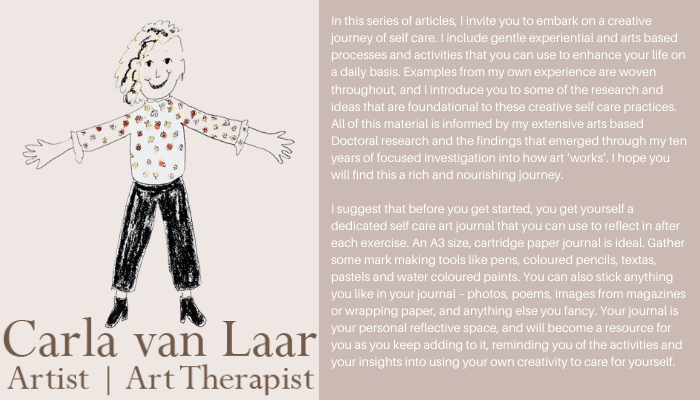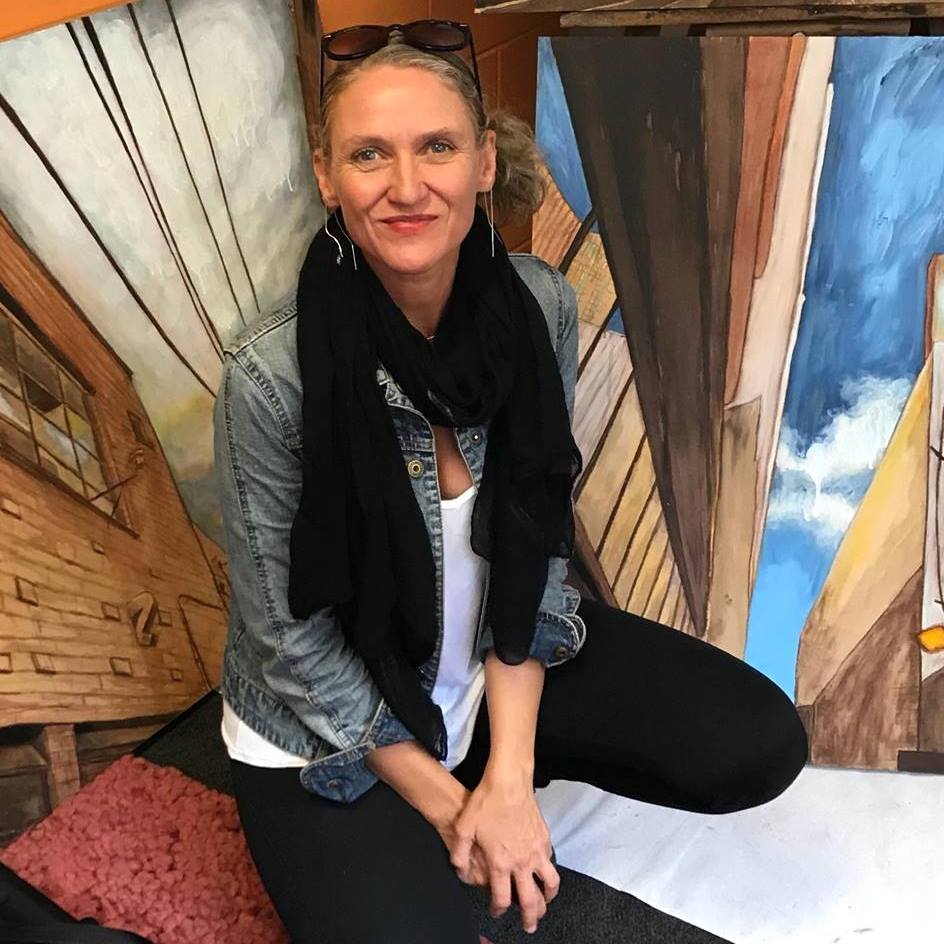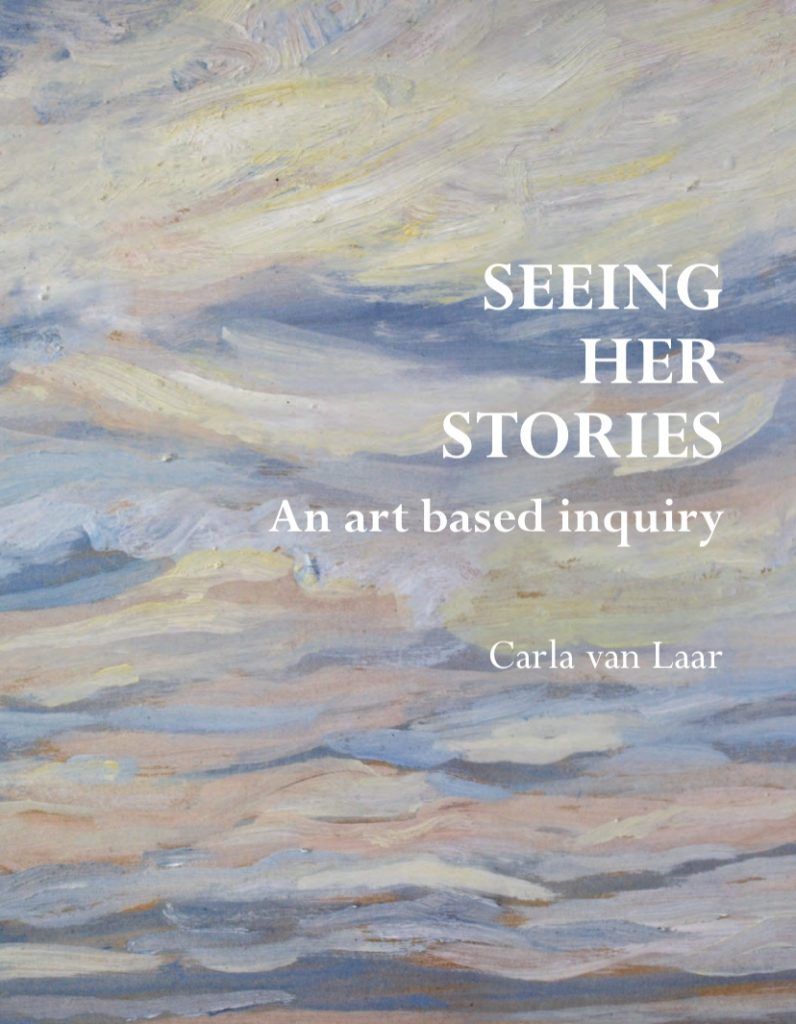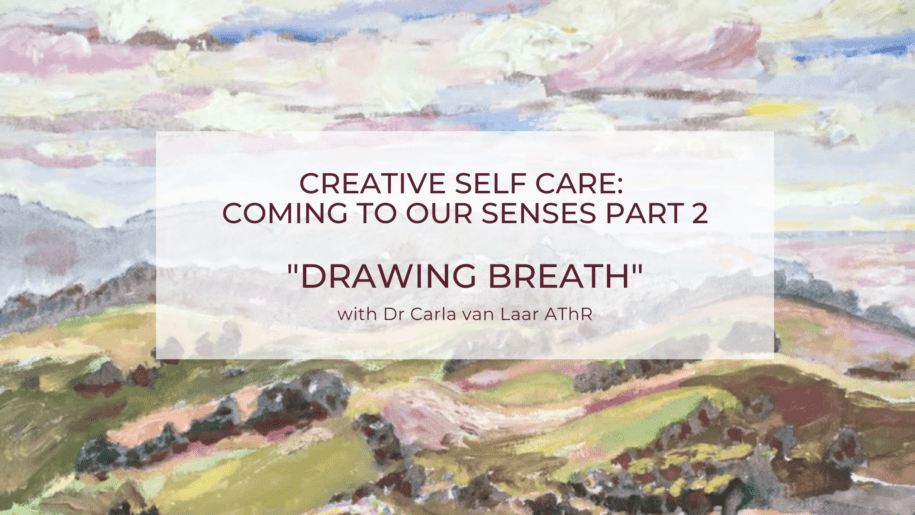With Dr Carla van Laar AThR
Feature image credit Carla van Laar
In this article I introduce the links between creative practices, mindful approaches, and traditional healing practices. I then invite you to use the process of drawing your breath as a mindful activity.

As part of my Doctoral research, I investigated how mindful processes are used in Arts Therapy. I found:
Cultivating awareness of presence in the here and now and feeling connected to embodied experiencing share common threads with many ancient wisdom traditions. Art therapists have explored these commonalities, and somatic experiencing approaches are particularly interested in how art based processes can facilitate mindful and regulatory experiencing.
Peter Levine (1997) developed the somatic experiencing approach to therapy, with a particular interest in alleviating the long lasting effects that trauma can have by using body based and present moment awareness methods. This approach was initially radically different from psychological and talking therapy, and is now gaining momentum as a benchmark for practice in responding to trauma. (Levine, P.A., 2012a; Levine, P.A., 2012b; Levine, P.A., 2015; Levine and Kline, 2014; Malchiodi, 2008, 2014; van der Kolk, 2014). Levine’s approach is supported by increasingly widespread interest in neurobiological evidence, and embracing of the “bottom up” approach, in which neural structures are recognised as dynamic and shaped by embodied experience (Doidge, 2008; Doidge, 2016).
P. A. Levine (2015) explains the relationship that somatic experiencing (SE) shares with embodied wisdom traditions and other Western methods that draw from these, saying:
“SE shares this focus on internal awareness with traditional methods of meditative movement, such as Yoga, T’ai Chi and Qigong, as well as many forms of seated meditation (Schmalzl et al., 2014). Less well-known Western-grown therapeutic (“Somatic”) systems such as the Alexander Technique (Stuart, 2013), the Feldenkrais method (Feldenkrais, 2005), and Continuum (Conrad-Da’oud and Hunt, 2007), also use this general approach”. (Levine, P.A., 2015, p. 93)
Gendlin’s (1981, 1996) Mind-body Focusing method can be added to this list. (van Laar, 2020, pp. 140-141)
Seigel (2019) has focused on paying attention to our breath during art therapy exercises. She writes:
“Breath, which pumps healthy oxygen into our bodies more than 20,000 times a day, is common to all living things. Developing a deep understanding of the process of breathing can reveal to us our inherent connectedness with all of life. Breathing, which has long been known to aid in relaxation and pre-exercise during stretching, is a focus in most meditation practices and serves as a vital reference point from which the mind wanders and is drawn back. Breath work can expand the uses of breathing to include rhythms that speak to both our life forces and our creative processes” (p. 251).
In the following exercise, “drawing breath”, you are invited to, very gently, use your awareness and connection with your own breath as a mindful drawing activity. This activity is an adaptation of an exercise published in Cohen, Barnes and Rankin’s (1995) Managing traumatic stress through art: Drawing from the center.
Drawing breath
You will need
Three pieces of paper to draw on – these could be pages in your journal
If you are using loose pages of paper you might like to tape it to the table top with masking tape on the corners
Drawing materials such as pastels, pencils or markers
……
The Process
Drawing One
Begin by sitting or standing comfortably, placing your hands on your belly, and taking three lovely big deep breaths. Focus on your fingers, feeling the expansion of your stomach area as you breath in, and the contraction as you breathe out.
Repeat until you feel connected with your breath in the here and now.
Next, sit comfortably at a table. Place a piece of paper in front of you. Keeping your eyes open, choose something to make marks with – a pencil, paster, or marker – and hold it in your usual hand.
Once again, focus your attention on your breath. Let your pencil, pastel or marker touch the paper in front of you.
Keeping your eyes open, as you breath in, start to move your hand in rhythm with your breath, making a continuous line on the page as you breath in and out, gently, slowly, tracing your breath.
Do this for about a minute, or until you come to a natural close.
Have a look at what you have drawn and notice what you see.
Drawing Two
Next, place a fresh piece of paper in front of you and select something to draw with.
This time, close your eyes as you place your pencil, pastel or marker on the page. Feel the tip of your drawing material touching the paper as you breath in and out, allowing your hand to move around the page, creating a continuous line as you trace your breath. Keep going for at least a minute, longer if you like.
When you are ready, open your eyes and have a look at what you have drawn. Notice what you see this time.
Drawing Three
Next, once again, place a fresh piece of paper on the table in front of you. This time, select two things to draw with, and place one in each hand.
Close your eyes, and allow both your hands to rest on the page. Focus on your breath, breathing in, and out.
Gently allow both of your hands to start moving around the page, making continuous lines, tracing your breath.
Keep breathing in, and out, drawing your breath. Keep on going for as long as you like.
When you are ready, open your eyes.
Look at what you have drawn. What do you see?
…
Questions for reflective journalling
Place all three drawings next to another and look at them together.
What do you notice about your drawings?
What is different? Can you see how your drawing changed when you closed your eyes, and then when you used two hands?
What is similar between all of the drawings? Are they connected in any way?
What do these drawings tell you about yourself?
…
Taking it further
If you like, you can use any or all of these drawings as a starting place for further art making. You might like to add in colour, highlighting or colouring in shapes, or you might have seen something in your breath drawing that you would like to bring out by working into the drawing more, like a figure, symbol, or an image.
…
References
Cohen, B. M., Barnes, M. M., & Rankin, A. B. (1995). Managing traumatic stress through art: Drawing from the center. Sidran Traumatic Stress Ins.
van Laar, C. Seeing Her Stories. Carlavanlaar.com, Brunswick, Australia.

Dr Carla van Laar
Artist | Art Therapist
Master of Creative Arts Therapy
Doctor of Therapeutic Arts Practice
Registered Supervisor and Professional Member ANZACATA
Carla van Laar is a painter and therapeutic arts practitioner from Australia. Born in Brisbane, Carla is first generation Australian on her Dutch grandparents side, and 7th generation through her maternal bloodline who were mostly English and came to Australia in the early colonisation of the 1800s. Carla currently lives and works in Victoria, residing between Wurrundjeri country in Melbourne, and Boon Wurrung country in Inverloch, paying deep respects to the First Peoples of the Kulin Nations whose land was never ceded and will always be Aboriginal land. Identifying as a cisgender woman, Carla is passionately disinterested in socially constructed identities that disempower anyone. Carla has over 25 years’ experience working with people and the arts for health and well-being in community organisations, justice, health and education contexts.
Carla’s first book “Bereaved Mother’s Heart” was published in 2007 and broke social taboos about maternal grief. From 2008-18 she established and ran an independent art therapy studio and gallery in Melbourne. Her Doctoral research “Seeing Her Stories” continues the mission to make women’s stories visible, through art.
Carla has lectured and supervised Art Therapy students at RMIT, MIECAT and currently the IKON Institute. She is a practicing artist and in 2018 received an Artist Fellowship at RMIT’s creative research lab, “Creative Agency”. She insists on being part of a creative revolution in which art re-embodies lived experience, brings us to our senses, makes us aware of the interconnectedness of all life and is an agent of social change.
Carla’s new book “Seeing her stories” presents her research into making unseen stories visible through art, and is available to read for free online here or purchase a hard copy of the full colour hard cover coffee table book here.



Leave a Reply